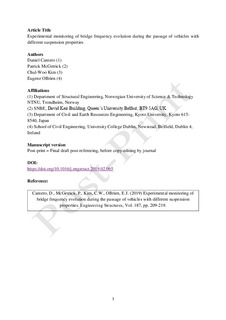| dc.contributor.author | Cantero, Daniel | |
| dc.contributor.author | McGetrick, Patrick | |
| dc.contributor.author | Kim, C. W. | |
| dc.contributor.author | OBrien, Eugene J | |
| dc.date.accessioned | 2019-05-23T07:10:44Z | |
| dc.date.available | 2019-05-23T07:10:44Z | |
| dc.date.created | 2019-03-05T09:21:27Z | |
| dc.date.issued | 2019 | |
| dc.identifier.citation | Engineering structures. 2019, 187 209-219. | nb_NO |
| dc.identifier.issn | 0141-0296 | |
| dc.identifier.uri | http://hdl.handle.net/11250/2598506 | |
| dc.description.abstract | The natural frequencies of coupled vehicle-bridge systems change with vehicle position. These changes are generally attributed to the contribution of the additional mass of the vehicle. However, other mechanical properties of the vehicle influence the evolution of the vehicle-bridge system frequencies, an aspect that has rarely been addressed. The aim of this paper is to further explore how frequencies vary during a vehicle passage and empirically show that the frequency shift depends also on the vehicle-to-bridge frequency ratio. The responses of a scaled model of a vehicle traversing a bridge are measured and analysed. The signals are processed in the time-frequency domain to assess the non-stationary and non-linear nature of the responses. The interpretation is supported with the predictions of a coupled vehicle and bridge numerical model. The results confirm different frequency shifts for vehicles with the same mass but different suspension properties. Furthermore, the direct (sensor on bridge) and indirect (sensor on vehicle) methods of extracting the bridge fundamental frequency are compared. The implications of these findings for indirect or drive-by bridge monitoring techniques are discussed. | nb_NO |
| dc.language.iso | eng | nb_NO |
| dc.publisher | Elsevier | nb_NO |
| dc.rights | Attribution-NonCommercial-NoDerivatives 4.0 Internasjonal | * |
| dc.rights.uri | http://creativecommons.org/licenses/by-nc-nd/4.0/deed.no | * |
| dc.title | Experimental monitoring of bridge frequency evolution during the passage of vehicles with different suspension properties | nb_NO |
| dc.type | Journal article | nb_NO |
| dc.type | Peer reviewed | nb_NO |
| dc.description.version | acceptedVersion | nb_NO |
| dc.source.pagenumber | 209-219 | nb_NO |
| dc.source.volume | 187 | nb_NO |
| dc.source.journal | Engineering structures | nb_NO |
| dc.identifier.doi | 10.1016/j.engstruct.2019.02.065 | |
| dc.identifier.cristin | 1682265 | |
| dc.description.localcode | © 2019. This is the authors’ accepted and refereed manuscript to the article. Locked until 4 March 2021 due to copyright restrictions. This manuscript version is made available under the CC-BY-NC-ND 4.0 license http://creativecommons.org/licenses/by-nc-nd/4.0/ | nb_NO |
| cristin.unitcode | 194,64,45,0 | |
| cristin.unitname | Institutt for konstruksjonsteknikk | |
| cristin.ispublished | true | |
| cristin.fulltext | postprint | |
| cristin.qualitycode | 2 | |

